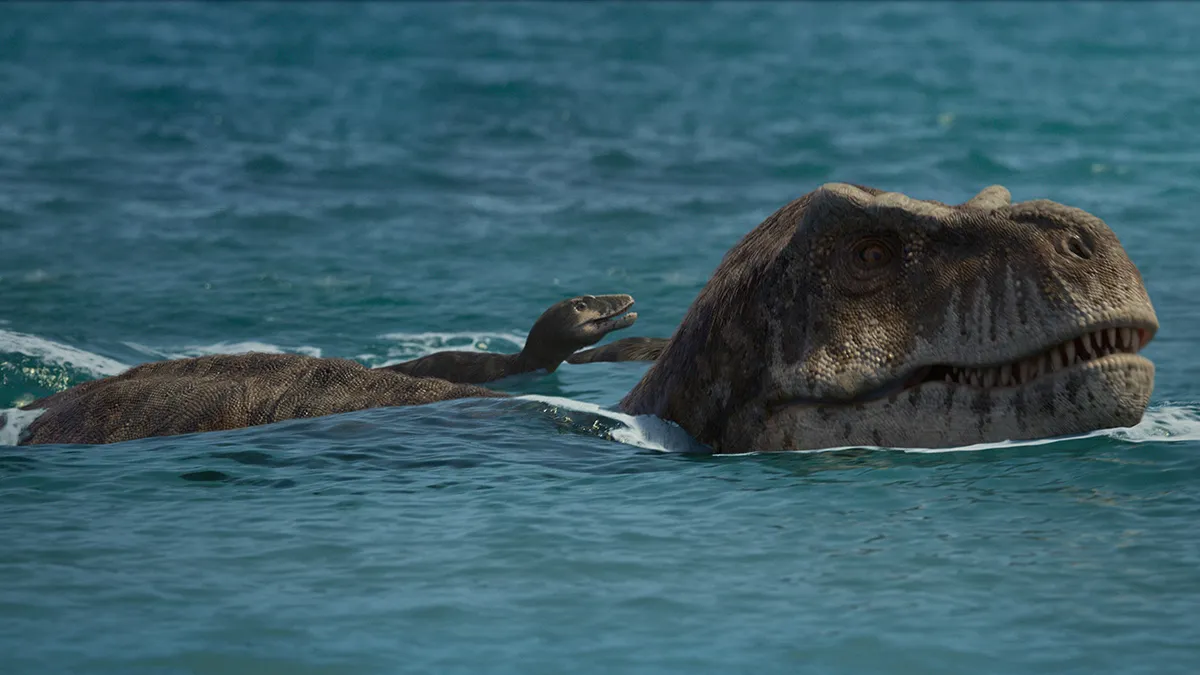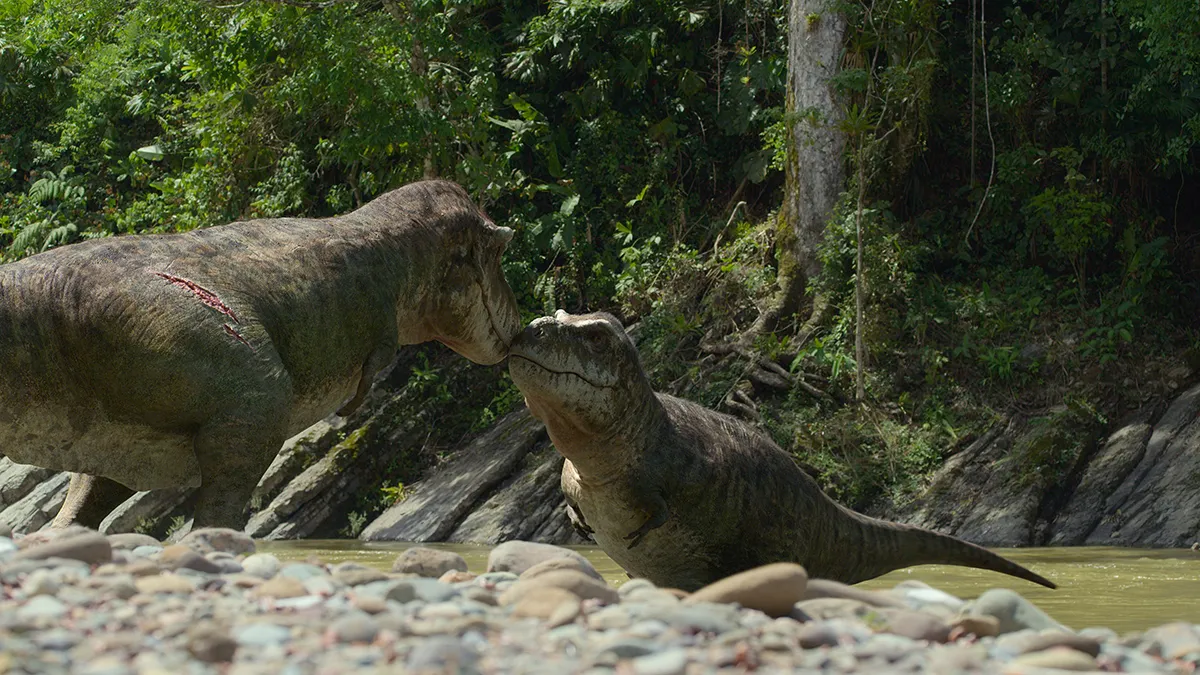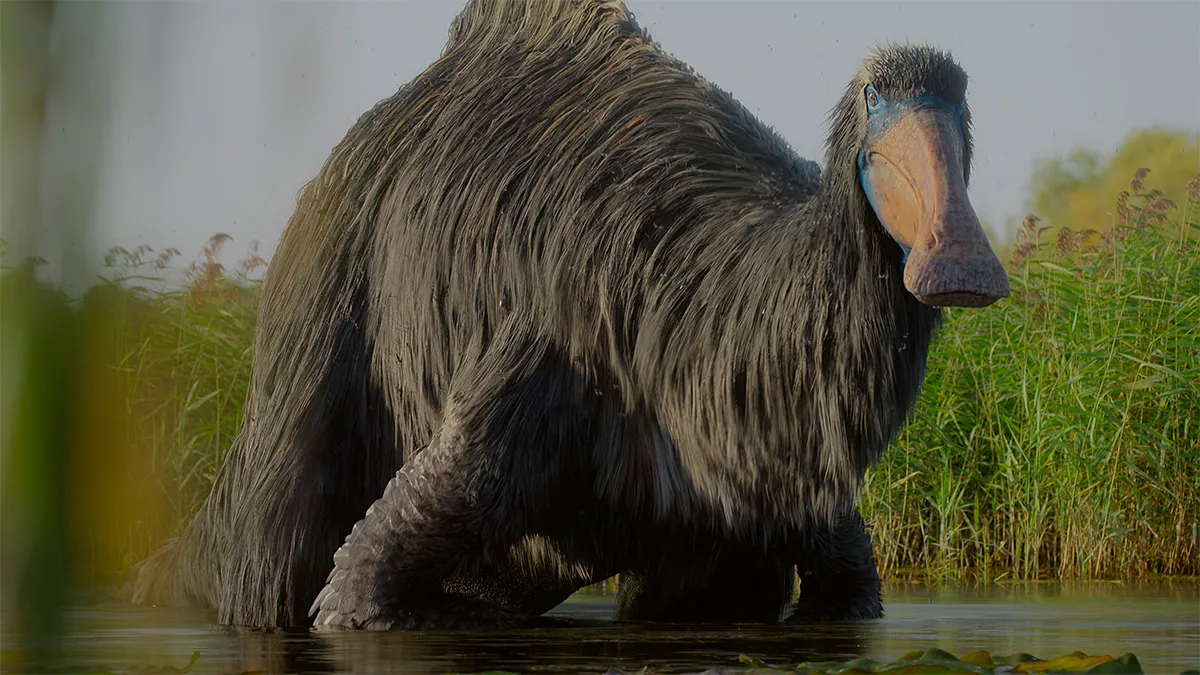Prehistoric Planet, the latest documentary from Sir David Attenborough, is premiering on Apple TV+ this week. The five-part series looks at how dinosaurs and other prehistoric creatures lived in different habitats around the world in the late Cretaceous Period.
We spoke to the series producer, Tim Walker, and the show’s consultant palaeontologist, Dr Darren Naish, about how they brought long-dead species back to life.
Tell us a bit about the show.
Tim Walker: Prehistoric Planet is basically the definitive natural history wildlife film about dinosaurs and the other ancient animals that lived alongside them right at the end of the dinosaur era.
We had an ambition which was to make a series that looks as though we took the best filmmakers from the BBC’s Natural History Unit, stuck them in a time machine, and sent them back to film the prehistoric planet.
Now of course, to realise that ambition required us doing this incredible collaboration where we took the filmmakers from the Natural History Unit, we were headed up by Mike Gunton, who's the creative director of the BBC's NHU. Take his creative genius and marry it together with Jon Favreau, who has become a guru of CGI expertise, having done photo-real animals in The Jungle Book and The Lion King. That's how the marriage came together. Three and a half years later, we have now realised that ambition.

The show opens with a swimming T. rex. How do we know they would have been able to do that?
Darren Naish: The main aim with the series is to reveal an absolutely modern, up-to-date view of dinosaurs and the other animals of their time. And obviously we're portraying them as live animals.
There's a ton of information in the fossil record. We know a huge amount of things about what these animals were like and what they did. But there's an enormous number of things that they would have done that the fossil record often can't show us or it can only hint at.
Would it have occasionally swam? Well, all living animals swim. There aren't any that don't. There's a list of animals that people say can't swim. Not true. They all can. The [modern] animals most similar to dinosaurs like T. rex are things like ostriches and emus, and they're excellent swimmers. And of course, so are other giant animals today that live near coasts. Famously, elephants and even horses and camels, they're all excellent swimmers.
T. rex also has pneumatic bones. It's got an air-filled skeleton, which means that it would have been especially buoyant, it would have been good at floating if it wanted to. And it had huge, thickly padded feet, which would have been really good at spreading its weight. It would have been good on unstable, soft surfaces. This wouldn't be an animal afraid to walk on the beaches and soft muds and such. So if you combine all of that, even without looking at direct fossil evidence, there's good reason for thinking T. rex would be an excellent swimmer.
T. rex in particular is a species that people have very strong opinions on what it should look like. How did you decide how to represent T. rex?
DN: As an academic palaeontologist, I'm contributing to the scientific research on dinosaurs. I publish several technical papers a year. This project is unique in that I was involved from the start, throughout every step of the process. And one of my jobs was to ensure that our reconstructions are up to the minute, as best as possible.
There's more discussion and more fighting about the appearance of Tyrannosaurus rex than virtually any other fossil animal. What do we actually think about the look of the face? How extensive were the soft tissues? Did this dinosaur have 'lips'? Air quotes around lips, because they're not lips like mammal lips. They're lips like lizards' and snakes' lips. Did it have those sheathing its teeth? How big were its eyes? Did it have entirely scaly skin? Did it have some sort of filamentous fuzz on its body?
We considered all of these things at great length. We went with the views that are scientifically best supported and you are seeing a phenomenally up-to-date view.
There's no way you can ever say we've made the final decision on what these animals were like. But what you're seeing in Prehistoric Planet is the most up-to-date, most technically rigorous view of this animal's life appearance.
Read more about Sir David Attenborough's documentaries:
- Dinosaurs: The Final Day | A closer look at the fossil site uncovered in Attenborough's new show
- The chance discovery that uncovered a mammoth graveyard in Swindon and inspired the new Attenborough show
- In pictures: Sir David Attenborough's new series A Perfect Planet
The show focuses on the behaviour of them as living animals. How much of that is deduced from the fossil record, and how much is inferred from living animals?
TW: One of the things that we're very eager for people to see is that dinosaurs were perfectly adapted to their niches. If you look at the different challenges that the natural world imposes on any creature, it's the same across the globe. There can be 6,000 miles difference between two sets of animals faced with very similar conditions, and they perform very similar behaviours to act as a solution.
And that can translate across time as well. The same problems occurred 66 million years ago for any living creature as they do today. Animals adapt to those conditions, which means they perform a certain set of behaviours.
DN: There's all of these like specific details from the fossil record that give us at least some information on behaviours and specific bits of biology which we incorporated as much as possible.
So for a dinosaur like Tyrannosaurus rex, from tooth marks it left on the bones of other animals, we know exactly which species it was eating and how it was attacking them. We know from footprints exactly how it placed its feet, details of its gait. We know from some of these footprints, we know from associated skeletons, how social or anti-social some of these animals were. It's difficult to emphasise how much research we did for every single species you're seeing. What you actually see in the final thing is the tiny tip of the iceberg.
You combine that with a technique called phylogenetic bracketing. Let's say we have a question about the behaviour of T. rex, something that's not present in the fossil record. For example, what postures did these animals use during the breeding season?
So in those cases, the fossil record doesn't provide us with that information. We look at the behaviour present in the living animals that surround the fossil one on the family tree of life. Imagine [dinosaurs] on the tree of life. They've got living crocodiles and alligators that bracket them on one hand and living birds bracket dinosaurs like T. rex on the other hand. If you see a specific behaviour in crocodilians and in birds, you can infer that it was present in your extinct dinosaurs as well.
I think it's the first time [this technique has] ever been implemented.
On the subject of mating behaviours, I think we should probably talk about what I think is going to be one of the most iconic moments in the series, which is the T. rex mating sequence. How did you go about making it feel so real?
TW: That sequence is probably my favourite sequence of the whole series. It is fabulous, and based on very, very good research.
Our executive producer Mike Gunton tells this great story about when Sir David was doing the voiceover. Afterwards, he took his earphones off and he said, "watching those T. rexes during that courtship, it was as if I was watching them through a pair of binoculars."

The reason it looks the way it does is that if you think about how you would film that for real, you would be out in the field in a very small team. Now, an encounter like that happening for real would probably be a very, very thrilling and exciting moment. And you'd likely only have one camera, at maximum two cameras, available to you. You would then have to think about where you going be to film it, because when it’s a 12- or 13-metre-long, multi-tonne animal, there's no way you'd be very close to it.
Across the whole series, these editorial limitations apply in the way that the whole thing has been created. We've created every sequence as if we were there filming it for real. So, you know, sometimes you can get very close to animals depending on what type they are and their behaviours. Other times you have to film using drones or film using very low-impact techniques whereby you're a long way away from the animals on a very, very long lens.
My favourite dinosaur from the series was Deinocheirus. It looks like something out of Star Wars. Can you tell us a bit about the species?
DN: Deinocheirus, it's this amazing late-Cretaceous theropod dinosaur from Mongolia. It was discovered in the late 1960s and long known just from its arms. Its name means 'terrible hand' because its describers were impressed by the eight-foot length of its arms and its giant, three-clawed hands. And it was initially assumed to be like a predator that used these big claws to rip other dinosaurs to pieces. But it was then realised that it was part of this group called the ostrich dinosaurs, which are mostly omnivores or herbivores.
So then people thought, well, what would the whole animal look like? It’s T. rex-size, 30 foot long, but it wouldn't have looked like a conventional predatory dinosaur.

This was answered in around about 2012 when it turned out that in Mongolia they'd actually discovered near-complete skeletons of this animal. And it's just this surreal beast. It's got this super-long duck-billed face; the skull is about a metre long. The animal was toothless, with a very deep lower jaw, and evidence from the shape of the skull that it was probably herbivorous.
It's found in a wetland environment. So, it's probably eating water weeds and stuff. It's got some fish preserved in its stomach contents along with stomach stones used to break up plant material. So it's mostly eating plants, occasionally eating some animals. It's got a sail on its back.
And because it's part of this ostrich dinosaur group, we know for sure from brilliant fossils that that group was feathery. So the giant Deinocheirus – was this animal feathery too? There's a bit of discussion about it, we're not absolutely sure, but we’ve gone with this view of it as this giant, shaggy, sail-backed, duck-faced, long-armed, wetland animal. It's going to be novel to 99 per cent of our audience. And what a beast to bring to the screen. Amazing-looking animal.
Read more about documentaries: